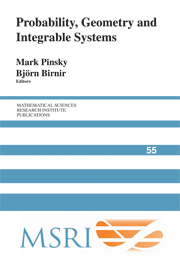Book contents
- Frontmatter
- Contents
- Preface
- Henry McKean: A tribute by the editors
- Bitangential direct and inverse problems for systems of differential equations
- Turbulence of a unidirectional flow
- Riemann–Hilbert problem in the inverse scattering for the Camassa–Holm equation on the line
- The Riccati map in random Schrödinger and random matrix theory
- SLE6and CLE6 from critical percolation
- Global optimization, the Gaussian ensemble, and universal ensemble equivalence
- Stochastic evolution of inviscid Burgers fluid
- A quick derivation of the loop equations for random matrices
- Singular solutions for geodesic flows of Vlasov moments
- Reality problems in the soliton theory
- Random walks and orthogonal polynomials: some challenges
- Integration of pair flows of the Camassa–Holm hierarchy
- Landen Survey
- Lines on abelian varieties
- Integrable models of waves in shallow water
- Nonintersecting Brownian motions, integrable systems and orthogonal polynomials
- Homogenization of random Hamilton–Jacobi–Bellman Equations
A quick derivation of the loop equations for random matrices
Published online by Cambridge University Press: 27 June 2025
- Frontmatter
- Contents
- Preface
- Henry McKean: A tribute by the editors
- Bitangential direct and inverse problems for systems of differential equations
- Turbulence of a unidirectional flow
- Riemann–Hilbert problem in the inverse scattering for the Camassa–Holm equation on the line
- The Riccati map in random Schrödinger and random matrix theory
- SLE6and CLE6 from critical percolation
- Global optimization, the Gaussian ensemble, and universal ensemble equivalence
- Stochastic evolution of inviscid Burgers fluid
- A quick derivation of the loop equations for random matrices
- Singular solutions for geodesic flows of Vlasov moments
- Reality problems in the soliton theory
- Random walks and orthogonal polynomials: some challenges
- Integration of pair flows of the Camassa–Holm hierarchy
- Landen Survey
- Lines on abelian varieties
- Integrable models of waves in shallow water
- Nonintersecting Brownian motions, integrable systems and orthogonal polynomials
- Homogenization of random Hamilton–Jacobi–Bellman Equations
Summary
The loop equations of random matrix theory are a hierarchy of equations born of attempts to obtain explicit formulae for generating functions of map enumeration problems. These equations, originating in the physics of 2-dimensional quantum gravity, have lacked mathematical justification. The goal of this paper is to provide a complete and short proof, relying on a recently established complete asymptotic expansion for the random matrix theory partition function.
1. Background and preliminaries
The study of the unitary ensembles (UE) of random matrices [Mehta 1991], begins with a family of probability measures on the space of N × N Hermitian matrices. The measures are of the form where the function Vt is a scalar function, referred to as the potential of the external field, or simply the “external field” for short. Typically it is taken to be a polynomial, and written as follows. where the parameters are assumed to be such that the integral converges. For example, one may suppose thatis even, and tυ > 0. The partition function , is the normalization factor which makes the UE measures be probability measures. Expectations of conjugation invariant matrix random variables with respect to these measures can be reduced, via the Weyl integration formula, to an integration against a symmetric density over the eigenvalues which has a form proportional to (1-1).
Information
- Type
- Chapter
- Information
- Probability, Geometry and Integrable Systems , pp. 185 - 198Publisher: Cambridge University PressPrint publication year: 2008
